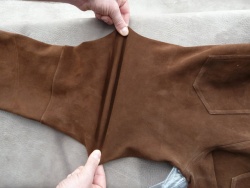Difference between revisions of "Leather lamination - Laminating leather"
| Line 5: | Line 5: | ||
==Lamination on the [[Flesh side|leather back side]]== | ==Lamination on the [[Flesh side|leather back side]]== | ||
| − | Laminating of leather means the coating or gluing of something to its backside. This backing can be made with a different type of leather, but also with films, foams or linings The lamination is done for protection reasons and to reinforce leather with the properties of the laminated material. | + | Laminating of leather means the coating or gluing of something to its backside. This backing can be made with a different type of leather, but also with films, foams or linings. The lamination is done for protection reasons and to reinforce leather with the properties of the laminated material. |
| − | When laminating [[car leather|car]] or [[leather furniture| | + | When laminating [[car leather|car]] or [[leather furniture|furniture]] upholstery leather, the entire backside of the leather is laminated with a laminating material. A lamination material is about 3 to 4 millimetres thick. The adhesive is applied by means of pressure and temperature. |
| Line 31: | Line 31: | ||
</p> | </p> | ||
<p align=center> | <p align=center> | ||
| − | ''The [[Perforated leather|leather perforation]] in this case doesn't | + | ''The [[Perforated leather|leather perforation]] in this case doesn't go through the glued lamination.''<br></p> |
<p> </p> | <p> </p> | ||
| Line 51: | Line 51: | ||
| − | Advantages of this lamination: Leather can stretch over time. The leather becomes [[Dents - Over stretching - Sagging in leather|wavy and bumpy]]. This prevents the lamination. In addition, the lamination facilitates to | + | Advantages of this lamination: Leather can stretch over time. The leather becomes [[Dents - Over stretching - Sagging in leather|wavy and bumpy]]. This prevents the lamination. In addition, the lamination facilitates to achieve special shapes and replaces the otherwise conventional cushioning wool. |
| Line 75: | Line 75: | ||
==[[Colour migration#Colour migration by on the back of leather laminated material|Colour migration]]== | ==[[Colour migration#Colour migration by on the back of leather laminated material|Colour migration]]== | ||
| − | When laminating, care must be taken that dying textile fabrics can lead to a [[Colour migration#Colour migration by on the back of leather laminated material| | + | When laminating, care must be taken that dying textile fabrics can lead to a [[Colour migration#Colour migration by on the back of leather laminated material|colour migration]] of the dyes from the fabric through the leather to the visible side of the leather. |
Revision as of 11:50, 10 December 2016
Contents
Lamination on the leather back side
Laminating of leather means the coating or gluing of something to its backside. This backing can be made with a different type of leather, but also with films, foams or linings. The lamination is done for protection reasons and to reinforce leather with the properties of the laminated material.
When laminating car or furniture upholstery leather, the entire backside of the leather is laminated with a laminating material. A lamination material is about 3 to 4 millimetres thick. The adhesive is applied by means of pressure and temperature.
The fabric lamination is well glued.
The leather perforation goes through the glued lamination.
The leather perforation in this case doesn't go through the glued lamination.
The lamination can be made of a wide range of materials.
Fabric lamination behind the perforation.
Advantages of this lamination: Leather can stretch over time. The leather becomes wavy and bumpy. This prevents the lamination. In addition, the lamination facilitates to achieve special shapes and replaces the otherwise conventional cushioning wool.
The lamination makes it possible to achieve special shapes more easily.
Stretch leather
In the case of stretch leather, a flexible fabric is laminated to the back of the leather.
Leather trousers made of laminated stretch leather.
Colour migration
When laminating, care must be taken that dying textile fabrics can lead to a colour migration of the dyes from the fabric through the leather to the visible side of the leather.
Colour migration in the area of back lamination with a dark fabric.
Colour migration or adhesive migration in the area of back lamination with a white fabric.
Additional information
























 a kotori web solution
a kotori web solution